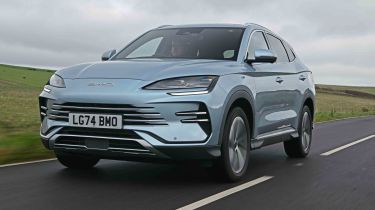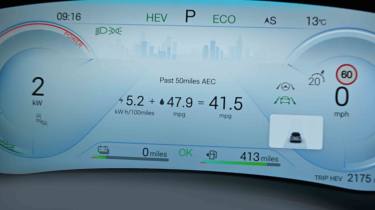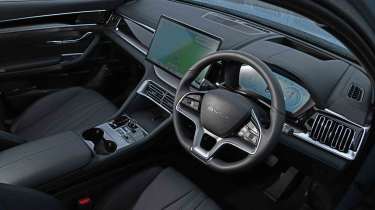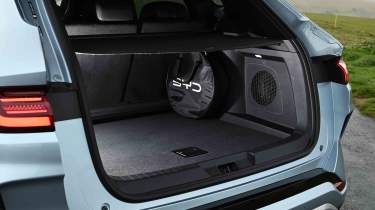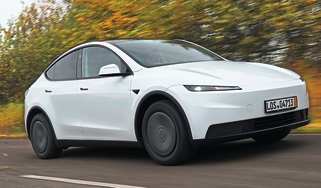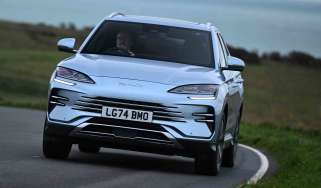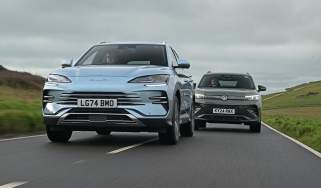BYD Seal U review
Arrival of the BYD SEAL U plug-in hybrid SUV marks new territory for the Chinese maker in the UK

Is the BYD Seal U a good car?
There’s a lot going for the BYD Seal U. It has a spacious cabin and comes with plenty of tech for a relatively low price, but there are compromises to be had in terms of the way it drives. You don’t expect a family SUV to deliver sports car-like handling, but the Seal U fails to get the basics right, with vague steering and an inconsistent ride being the real disappointments. Boot space is behind the class leaders, too. If you can overlook these flaws, then there are positives, such as the long all-electric range, decent passenger space and good build quality.
Key specs | |
| Fuel type | Petrol, plug-in hybrid |
| Body style | Five-door compact SUV |
| Powertrain | 1.5-litre 4cyl petrol plus 1x e-motor 1.5-litre 4cyl turbo petrol plus 2x e-motor |
| Safety | 5-star Euro NCAP (2023) |
| Warranty | 6yrs/93,750 miles |
About the BYD Seal U
In China, the BYD Seal U is known as the Song Plus, and is a car that has been on sale there since 2020 – in fact, it’s the company’s best-selling model. The Song Plus was facelifted in 2023, and that’s the car we get in the UK as the Seal U DM-i, where the ‘U’ stands for utility (to differentiate this model from the Seal electric saloon), and DM-i signifies the ‘Dual Mode’ PHEV powertrain.
The main talking point of the Seal U is its price. Starting at around £33,000, this plug-in hybrid model undercuts even conventional combustion-engined versions of established rivals, while the kit list is similar to that of a high-spec machine costing thousands more.
The Seal U is the first petrol-electric model from BYD to be launched in the UK, but it’s far from being its first combustion-engined car. When it originally launched in China in 2020 it was petrol-only, with this PHEV version and a full EV variant arriving later. The 2023 update saw the petrol model dropped, with BYD concentrating on alternatively fuelled models. Incidentally, while we don’t get the electric Seal U in the UK, it is available in Europe. BYD expects that the Sealion 7 electric SUV will be able to meet UK demand.
There’s just one body style available, a conventional looking five-door, five-seat family SUV, while the three trim levels comprise Boost, Comfort and Design. A modest price walk of around £2,000 from Boost to Comfort spec is worthwhile to get a larger drive battery, while the more powerful, four-wheel-drive Design model is nearly £5,000 extra on top of that.
BYD Seal U prices and latest deals
How much does the BYD Seal U cost? Well, official ‘on the road’ prices range from £33,205 to £39,905 but you can currently save an average of £2,478 through the Auto Express Find A Car service, where prices start at £31,040. Don’t want to buy? You can lease a BYD Seal U from £315 per month.
Check out our latest new car deals and leasing deals for the top offers available now on Auto Express. And don't forget we can help you sell your car, too.
Engines, performance & drive
There’s just one powertrain option in the BYD Seal U, but it comes in three different configurations depending on which trim level you choose. The system comprises a 1.5-litre turbocharged four-cylinder petrol engine, one of BYD’s Blade batteries (as used in its EVs, but smaller in this application), an electric motor and a CVT-style transmission that manages the energy flow between the two power sources and the wheels.
The Boost model has a combined output of 214bhp and 300Nm of torque, while an 18.3kWh battery offers a claimed range of 50 miles. The mid-range Comfort has the same engine, but the battery is bigger, at 26.6kWh, so it has a claimed range of 78 miles.
At the top of the range, the Design model has an electric motor on each axle for a total system output of 319bhp and 550Nm of torque. Installing a second rear motor takes up space at the back of the Seal U, so the smaller 18.3kWh battery is fitted, and this offers an all-electric range of 43 miles on this more powerful model.
Acceleration is brisk in the 214bhp models, with a 0-60mph time of 8.9 seconds quoted. The four-wheel-drive model manages it in 5.9 seconds, which is very rapid for a car that has a gross weight in excess of 2.5 tonnes.
While the Seal U doesn’t throw up any quirks from behind the wheel, it’s not enjoyable to drive and offers zero involvement. A high driving position offers a decent view forwards, while parking sensors and a 360-degree camera system provide reassurance when manoeuvring this relatively large family SUV. The sloping nose can make it hard to judge where the front of the car is, while the back window is narrow, which restricts rearward vision.
Refinement at low speeds is at its best in full EV mode, but when the engine does fire up, it’s largely unobtrusive at lower revs. The Seal U’s powertrain is biased towards the electric motor, which makes 194bhp when compared with 95bhp from the petrol engine. As a result the powertrain offers the feeling of a range-extending hybrid because it uses electric drive most of the time, but when the engine does cut in, its revs do match the car’s road speed, unlike some rivals using a similar type of set-up.
Go a little faster, and the shortcomings of the Seal U’s chassis become apparent. The ride is soft and wallowy over a typically bumpy British A-road, with plenty of body movement, both back and forth and side to side. The car’s heavy kerbweight translates into roll in corners, while the steering is devoid of any feedback, so fast changes of direction are not the car’s forte.
Power delivery is fine at these speeds, with the electric motor providing most of the acceleration, although if you do need petrol back-up, there is a slight delay in its response. Sport mode lets the engine run for longer to smooth things out, and this also puts a small amount of energy back into the battery, too.
The remote, floaty sensation of the BYD’s suspension helps it to be relatively refined at motorway speeds, while cat’s eyes and expansion joints are heard more than felt when running over them. However, this also emphasises the lack of feedback that comes through the steering wheel.
Accelerating up to speed on slip roads sees the engine revs soar and a harsh note from under the bonnet, but that is only really noticeable because the cabin is so quiet the rest of the time. Wind noise from the door mirrors starts at around 60mph, but otherwise the cabin is a refined place to be.
Model |
Power |
0-62mph |
Top speed |
| BYD Seal U DM-i Boost | 215bhp | 8.9 secs | 106mph |
| BYD Seal U DM-i Design | 319bhp | 5.9 secs | 112mph |
MPG, emissions & running costs
Low list prices will draw buyers to the Seal U, and on the whole, the everyday running costs should be manageable. As with any other plug-in hybrid, the fuel economy that you achieve will be determined by how often you charge the battery. With such a large difference in power outputs between the electric and petrol power sources, we’d recommend charging as often as possible.
This is a big car for the relatively low-powered engine to haul around, and while BYD quotes 50.5mpg with the battery depleted, we saw figures around 35mpg when driving on the motorway on petrol power alone – although this improved to the mid-40s at lower speeds as the electric system did more of the work.
A full charge of the 26.6kWh battery in the Comfort model offers a WLTP range of 78 miles; the smaller 18.3kWh pack delivers 43-50 miles, and according to the car’s trip computer, a test of the top Design model garnered a maximum range of 42 miles from a full charge.
BYD offers DC charging, but the maximum rate is only a modest 18kW. This can take the large battery from 30-80 per cent in 55 minutes, while the smaller pack takes 35 minutes to charge to the same capacity.
For AC charging, there’s a maximum of 11kW available, which can take the small battery from 15 per cent to a full charge in two hours. The larger battery takes around three-and-a-quarter hours to fully charge.
Low emissions and a long EV range mean the Seal U is a competitive choice as a company car. It sits in the lowest Benefit-in-Kind bracket for plug-in hybrids while the low list prices keep costs down, too.
That’s also to the benefit of annual road tax (VED), because no model breaches the £40,000 mark for the luxury-car supplement. Adding plug-in drive to most of the Seal U’s rivals sees them break that barrier quite easily.
The BYD Seal U sits in some quite high insurance groups, ranging from 32 for the two-wheel-drive models to 40 for the powerful top-spec car, which is on par with models such as the Porsche Macan. Closer rivals, such as the Volkswagen Tiguan, sit five or more groups lower.
Residual values in the 50-55 per cent range are decent for a new car from what is still a relatively unknown brand. To put that into perspective, the latest VW Tiguan in plug-in hybrid guise has residuals that are in a similar ballpark.
To get an accurate valuation on a specific model check out our free car valuation tool...
Model |
MPG |
CO2 |
Insurance group |
| Seal U DM-i Boost | 313.9mpg | 21g/km | 32 |
| Seal U DM-i Comfort | 706.8mpg | 9g/km | 32 |
| Seal U DM-i Design | 235.4mpg | 26g/km | 40 |
Design, interior & technology
The BYD Seal U has a fairly generic five-door SUV shape. It’s a large car – longer than a Skoda Kodiaq and with a similar profile – but the smooth nose and tailgate light bar are parts of a template that has been used by a number of other new SUVs from China.
Inside, there’s lots of kit on board and a clean layout with a few touches to help it stand out, while material quality is decent for the price. The cabin is inoffensive, with synthetic leather trim boosting the quality of the dashtop, centre console and seats, while brushed aluminium and gloss-black trim add to the premium feel inside.
There’s a solid feel when you open and close the doors, while the drive selector and major controls all feel good to use. The grille-style air vents at either end of the dashboard feel a little flimsy to use, but overall the cabin seems solid, with no squeaks or rattles from the interior trim.
Sat-nav, stereo and infotainment
BYD has fitted its party-piece rotating 15.6-inch touchscreen to the Seal U. The whole display turns through 90 degrees from landscape to portrait, although as in other models fitted with this set-up, you’ll probably turn it back and forth a couple of times before deciding which layout you prefer and sticking with it.
In portrait mode, the screen sits quite high on the dashboard so the bottom edge clears the air vents located beneath it, although it’s not tall enough to obscure your view out as it does in some smaller BYD models.
With so much real estate on offer with the Seal U’s large touchscreen, it’s a shame that BYD hasn’t given more space to permanent controls. Many rivals do this, but here there’s just a single narrow strip across the bottom with temperature settings at either end and six other shortcuts. One of these is to rotate the screen through 90 degrees, which seems like a pointless addition.
A more useful feature is that the screen can be split in two to show different functions at the same time, either side-by-side or stacked vertically when in portrait mode.
One highlight of the Seal U’s on-board tech is a Vehicle-to-Load (V2L) function, which means you can use the car’s drive battery to power auxiliary items. The car has a two-way charge socket, so simply plug in a bespoke extension lead and you can connect any three-pin plug.
Boot space, comfort & practicality
The Seal U is a big car with decent rear-seat space, although some boot capacity has to be sacrificed to the plug-in powertrain.
Up front, the relatively tall centre console divides the cabin in two, but there’s plenty of room to get comfortable. The middle storage bin is deep as a result, while twin cup-holders and a pair of wireless smartphone charging pads also feature. The door pockets aren’t the biggest around, and while the glovebox is integrated with the opening door, it’s a decent size and shape.
Where the Seal U scores big is for back-seat space. There’s lots of legroom and the cabin is wide, so fitting three across the back will be fine. The middle seat is a bit narrower and firmer than the other two, but the flat floor means there’s no fight for foot space. This is doubly useful because the front seats are mounted low, so there’s no room beneath them. All versions of the Seal U come with a panoramic roof as standard, but this doesn’t have a detrimental effect on headroom.
Dimensions | |
| Length | 4,775mm |
| Width | 1,890mm |
| Height | 1,670mm |
| Number of seats | 5 |
| Boot space | 425-1,440 litres |
A high load lip is your first obstacle when it comes to loading the boot, while a capacity of 425 litres is more on a par with a compact hatchback than rival SUVs. The limited capacity can be attributed to the hybrid running gear, but the VW Tiguan PHEV has a more useful 490-litre boot.
The Seal U only has a small amount of under-floor storage, too, so charging cables will likely need to be carried in the main boot. Folding the back seats could be easier, because there are no release levers in the boot. They have a 60:40 split and a maximum capacity of 1,440 litres, but the seats don’t fold totally flush.
The Seal U doesn’t have a great towing capacity. In its standard two-wheel drive form, it can only manage a braked trailer of 750kg, while the four-wheel drive is rated to pull up to 1,300kg. That’s not very much for owners who want to pull a decent-sized trailer or caravan, and they’ll be better served by plug-in rivals such as the Honda CR-V and Ford Kuga.
Safety & reliability
While BYD is still a relative newcomer to the UK market, it’s been building cars in China for nearly 20 years. The Seal U benefits from this experience, as well as sharing parts with other models in the firm’s current line-up.
Euro NCAP tested the Seal U in 2023, and the car earned a five-star safety rating. It had strong scores across the board, while standard equipment includes front and rear cross-traffic alert, blind-spot detection, lane-departure prevention, adaptive cruise control and three sets of Isofix child-seat mounts.
The Seal U was marked especially highly for its assistance systems, and better still, the firm’s engineers have tweaked some of these features to be easier to turn off and less intrusive than their applications in the other BYD models we’ve tested.
A great way to allay fears about reliability is to offer a long warranty, and BYD covers the Seal U for six years or 93,750 miles (150,000km), while the battery and drive unit have eight years of cover (up to 125,000 miles for the 18.3kWh version and 200,000 miles for the 26.6kWh model), which guarantees that the battery won’t drop below 70 per cent of its original capacity over that time, and the bodywork is warrantied for 12 years against corrosion.
Service prices aren’t available for the Seal U just yet, but the car comes with intervals of 24 months or 20,000 miles, so that should help counter more expensive costs elsewhere.
Key standard safety features |
Euro NCAP safety ratings |
|
|
BYD Seal U alternatives
The BYD Seal U arrives in a market awash with SUVs of many shapes and sizes, and there are even many plug-in hybrid and hybrid SUVs to choose from for low running costs. However, with its mix of generous exterior dimensions and attractively low price, the Seal U attracts rivals from various classes.
For instance, in terms of interior space the BYD is closely matched to established plug-in models such as the Honda CR-V, Toyota RAV4 and Ford Kuga.
Yet consider the car’s pricing and the list of competitors is stretched to include the Hyundai Tucson and Kia Sportage, which both have plug-in options, as well as more traditionally-powered machines such as the Nissan Qashqai and Skoda Karoq.
Frequently Asked Questions
BYD offers a generous six-year and 93,750-mile warranty on all of its cars. If you’re wondering, the odd mileage limit equals 150,000km.

